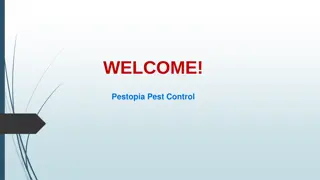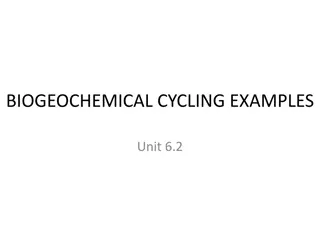Innovative Agricultural Trials for Pest and Nutrient Management
On-farm trials showcase effective solutions such as new chemicals and innovative approaches for managing pests like stem borers and thrips in crops like sorghum, tinda, and kinnow. Additionally, nutrient management through foliar applications has shown promising results in enhancing crop yields and quality. Farmers are adopting these technologies for improved sustainability and profitability in farming practices.
Download Presentation

Please find below an Image/Link to download the presentation.
The content on the website is provided AS IS for your information and personal use only. It may not be sold, licensed, or shared on other websites without obtaining consent from the author.If you encounter any issues during the download, it is possible that the publisher has removed the file from their server.
You are allowed to download the files provided on this website for personal or commercial use, subject to the condition that they are used lawfully. All files are the property of their respective owners.
The content on the website is provided AS IS for your information and personal use only. It may not be sold, licensed, or shared on other websites without obtaining consent from the author.
E N D
Presentation Transcript
On Farm Trials S. No. 1. 2. 3. 4. Title Number of farmers Stem borer management in sorghum. Sucking pest management in Tinda. Nutrient management in kinnow through foliar. Micro nutrient management in onion. 10 10 10 10 5. Use of probiotic to improve milk production in cattle. 10 Effect of chelated mineral mixture on milk yield in buffalo. Assessment of leaf color chart (LCC) for need-based nitrogen in wheat crop. 6. 10 7. 10
Crop: Sorghum Farming situation: Canal irrigated multiple cropping system, loam to clay loam soil. Problem identified: - Poor yield of Sorghum. Major cause: - Stem borer incidence and farmer s practices are not more effective. Possible solution: - Use of new chemical for effective control of stem borer. Title: - Stem borer management in sorghum (Kharif 2021). Thematic area: Pest management Technology option & Performance No. of replication:- 10 Net Returns (Rs./ha) Technology Option Pest reduction (%) Yield (q/ha) B:C Ratio T1-Lambda Cyhalothrin 5% EC @ 1.5 ml/lit. (FP) 61.15 463 33945 1.75 T2- Chlorantraniliprole18.5% SC @ 0.40 ml/lit. (Ass.) 71.26 496 35640 1.88 Results:- The highest yield, B:C ratio and % pest reduction and highest longevity duration of pest out break was found in T2. Farmers reactions:- Spray of Chlorantraniliprole were found highest longevity duration and pest outbreak. Social acceptability, Suitability & Economic viability:- The chemical is socially acceptable and most suitable for control of stem borer. It is also cost effective due to longevity duration. Source of technology:- PAU, Ludhiana
Crop: Tinda Thematic area: Pest management Farming situation: Canal irrigated multiple cropping system, loam to clay loam soil. Problem identified: - Low yield of Tinda. Major cause: - Thrips incidence and farmer s practices are not more effective. Possible solution: - Use of new chemical for effective control of thrips. Title: - Sucking pest management in Tinda (Kharif 2021). Technology option & Performance No. of replication:- 10 Net Returns (Rs./ha) 65857 Technology Option Pest Yield (q/ha) 61.12 B:C Ratio 2.56 reduction (%) 59.86 T1-Use of Fipronil 5% SC @ 1.5 ml/lit. water. (FP) T2-Use of Emamectin benzoate 5% SG @ 0.4 gm/lit. water. (Ass.) 80.56 83.20 76208 3.01 Results:- Spraying of Emamectin benzoate for thrips management was found effective as well as increased production, net profit and B:C ratio Farmers reactions:- Spray of Emamectin benzoate was more effective in terms of pest reduction and economics. Social acceptability, Suitability & Economic viability:- The technology socially acceptable, safer for natural enemies and cost effective. Source of technology:- TAU, Coimbatore
Crop: Kinnow Farming situation: Canal irrigated mono cropping system, loam to clay loam soil. Problem identified: - Low yield of kinnow. Major cause: - No use of nutrients as supplement. Possible solution: - Use of nutrients as foliar application. Title: - Nutrient management in Kinnow through foliar (2021-22). Thematic area: Integrated Nutrient management Technology option & Performance No. of replication:- 10 Net Returns (Rs./ha) 359690 Technology Option Yield (q/ha) 276.8 Increase in yield (%) - B:C Ratio 4.7 One spray of multi micro nutrients (Six elements) (FP) Three spray of ZnSO4 (0.3%) + MgSO4 (0.2%) + MnSO4 (0.2%) + K2SO4 (0.8%) + Urea (0.15%) from third week of May to August. (Ass.) 305.1 10.2 463335 5.6 Results:- The quality & size of improved and yield of fruits increased by 10.2% after 3 sprays of macro and micro plant nutrients at 20 days interval at fruit developing stage (during May to August) in Kinnow. Farmers reactions:- Farmers realized that the spray of macro and micro nutrients resulted in reduction of immature fruit dropping as well as increase in yield and quality of fruits. Social acceptability, Suitability & Economic viability:- No social issues to use macro as well micro nutrients. These are suitable for foliar spray in kinnow and are cost effective. Source of technology:- Central Citrus Research Institute, Nagpur
Crop: Onion Thematic area: Integrated Nutrient management Farming situation: Canal irrigated multiple cropping system, loam to clay loam soil. Problem identified: - Low yield of onion. Major cause: - No use of micro nutrients. Possible solution: - Use of micronutrients as foliar application. Title: - Micro nutrient management in onion (2021). Technology option & Performance Technology Option No. of replication:- 10 Net Returns (Rs./ha) 88388 Yield (q/ha) 184.4 Increase in yield (%) - B:C Ratio No use of micro nutrients (FP) One spray of multi micro nutrients {Six elements (Fe, Mg, Mn, Zn, Cu & Bo)} (Ass.) 1.9 198.9 7.9 100888 2.0 Results:- The yield of bulbs increased by 7.9% after one spray of multi micro nutrients (six elements) at 50 days after plantation @ 8 gm per liter of water. Farmers reactions:- The spray of multi micro nutrients resulted increase in yield and quality of bulbs. Social acceptability, Suitability & Economic viability:- Use of micro nutrients in onion is safe and socially acceptable. Suitable for the existing cropping system and economically viable because it increase the yield & quality. Source of technology:- CCSHAU, Hissar
Enterprise: Livestock Thematic area: Nutrient management Animal situation: Cross breed H.F. cow, 2nd lactation, reared under Intensive housing system. Problem identified: - Improper digestion. Major cause: - Insufficient digestion of feed stuff due to low microbial activity in rumen. Possible solution: - Anerobic and synergistic microflora to improve anerobic fermentation of feed stuff. Title: -Use of probitic to improve milk production in cattle. Technology option & Performance (Animal/day) Replications-10 animals Cost of feeding (Rs.) Gross return (Rs.) Net B:C Ratio Treatments Ave. Milk Prod. (lit.) 9.95 12.02 % increase in milk Returns (Rs.) Balanced feed. (no use of probiotics). (FP) Balanced feed + Probiotics 20 g/day. (Ass.) 20.8 179.0 192.0 298.5 360.6 119.5 168.6 1.67 1.88 Average sale rate of milk is Rs. 30/kg Source of technology: AAU, Anand Duration of trial: 60 Days Results:- The results indicate that use of probiotics improve digestibility of animal by increasing micro-flora in rumen. Resulting milk yield increase Farmers reactions:- Farmers were satisfied with the performance of probiotics. Social acceptability, Suitability & Economic viability:- These are micro-organism, so there is no social issues. These are synergetic in nature which support digestive system and easily available in market at reasonable price.
Enterprise: Livestock Thematic area: Nutrient management Animal situation: Murrha cross buffalo, 2nd lactation, reared under Intensive housing system. Problem identified: - Mineral deficiency. Major cause: - Non-chelated form of minerals not absorbed by intestine during digestion process. Possible solution: - Chelated form of minerals are organic form which is easily absorbed in intestine. Title: - Effect of chelated mineral mixture on milk yield in buffalo. Technology option & Performance (Animal/day) Replications - 10 animals Cost of feeding (Rs.) 198.0 208.0 Gross return (Rs.) 272.4 372.3 Net B:C Ratio Ave. Milk Prod. (lit.) % Treatments Returns (Rs.) 74.4 164.3 increase in milk 36.7 Balance feed + Mineral mixture (FP) Balance feed + Chelated Mineral mixture (30g/day) (Ass.) Note:-Average sale rate of milk is - 30Rs. 9.08 12.41 1.38 1.79 Source of technology: AAU, Anand Duration of trial: 60 Days Results:- The results of the trial indicate that use of Chelated Mineral mixture improve intake minerals in GI track with low dose as compare to mineral mixture. Resulting milk production and health improves. Farmers reactions:- Farmers satisfied with the performance of chelated mineral mixture & health of animal. Social acceptability, Suitability & Economic viability:- There is no social issue to accept the technology and no side effect on all categories of animals. Easily available in market at reasonable price (Rs. 100-150/kg).
Crop: Wheat Farming situation: Canal irrigated multiple cropping system, loam to clay loam soil. Problem identified: - Low profitable crop production (Wheat cultivation). Major cause: - Non-judicious use of nitrogenous fertilizer. Possible solution: - The LCC can be used to rapidly assess leaf N status and thereby guide the application of fertilizer N to maintain an optimal leaf N content. Title: - Assessment of leaf color chart (LCC) for need-based nitrogen in wheat crop (Rabi 2021-22). Thematic area: Integrated Nutrient management No. of replication:- 10 Net Returns (Rs./ha) 78949 80654 Technology option & Performance Technology Option Yield (q/ha) Increase in yield (%) -- 0.34 B:C Ratio Farmer s practices. (Control) LCC based nitrogen management (Ass.) 46.89 47.05 3.6 3.69 Source of technology:- Punjab Agricultural University, Ludhiana Results:- The results showed that the difference in yield of T1 and T2 was found to be non significant. There was not much difference in the amount of nitrogen used by the farmer and the amount of nitrogen used with the help of leaf color chart (LCC). Social acceptability, Suitability & Economic viability:- The LCC is a simple handy, ever-lasting pocket tool, made up high quality plastic material and consists of 6 strips of different shades of green from pale green to dark green. Easy to use and inexpensive to chlorophyll meter. It helps farmers determine the right time and dose of N application.























